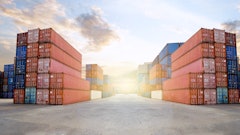Intermodalism can help solve the nation's transportation problems, according to recent testimony delivered to the U.S. House of Representatives' Committee on Transportation and Infrastructure.
Patrick Sherry, co-director of the National Center for Intermodal Transportation and a professor at the Intermodal Transportation Institute at the University of Denver, addressed the committee and identified five major challenges facing transportation.
Sherry told the panel that congestion, competition, capacity, conservation and connectivity are the primary challenges facing the transportation infrastructure and identified intermodal connectivity as the solution to the nation's transportation problems.
"Without a national transportation policy with incentives to establish a seamless intermodal transportation system, which would maximize interconnectedness while optimizing the cost efficiencies of the various modes of transportation, these problems will only further stress the U.S. infrastructure in the years ahead," he testified. Sherry cited the following problems facing the nation
Congestion: "Population concentration and increasing consumption of goods from Asia will continue to create pressure on the nation's transportation system," he said. "This situation will only get worse as projections for the next 20 years suggest a 40 percent increase in population and a 103 percent increase in transportation activity. Data provided by the USDOT also predicts the numbers of containers utilized in the already overburdened area of southern California alone to increase by 350 percent in the near future."
Conservation: "Rising fuel costs have once again gotten the nation's attention. Clearly, it is most advantageous to move cars and trucks off the roads to conserve fuel, and doing so will require policies and incentives to connect buses and light rail to airports for the movement of people and to move freight off the trucks and onto the more fuel-efficient railroads."
Capacity: "Intermodal freight traffic is expected to increase by about 6 percent a year, which means that productivity at our container terminals needs to improve drastically. Major ports like Singapore, Hong Kong and Rotterdam are able to move more than 30 containers an hour while our best systems are only capable of handling two-thirds that number. Increasing investments in new technologies will help increase productivity and operations within U.S. intermodal and port facilities and free up more capacity."
Competition: "Our transportation infrastructure contributes greatly to our national economic competitiveness. However, developing economies from Asia and around the world are building intermodal systems and increasing the rate of their economic growth. If the U.S. is to maintain its competitive edge in the global economy, it will have to enhance the economic advantages of its transportation infrastructure."
Connectivity: "The intermodal solution utilizes modal connectivity to decrease congestion, while increasing fuel conservation, infrastructure capacity and competition. However, our nation's transportation department plans and funding are lagging behind our 21st Century transportation requirements."
A recent study by NCIT on state departments of transportation indicated that since the early 1990s, intermodalism and intermodal planning has improved, but may now be leveling off. The study showed that while many state DOTs are more attuned to intermodal issues, as many as 20 states still did not have an office devoted to intermodal freight planning, and, among those that did, the staff was largely filled with highway engineers, and a majority of the funding still went to highway projects.




























